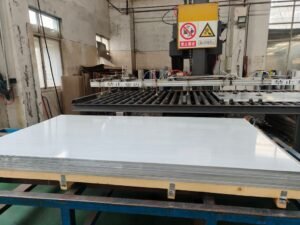Introduction
Did you know that corrosion costs the automotive industry billions each year, weakening vehicle parts and compromising safety? Automotive stainless steel is changing that by offering unmatched durability and resistance to harsh conditions, a must-know for engineers aiming to enhance vehicle longevity.
This material not only withstands extreme wear but also boosts safety through superior crash performance and reduces weight for better fuel efficiency. In this article, we’ll dive into how automotive stainless steel drives innovation, with insights from crash tests and supply chain strategies that ensure reliable OEM partnerships, like those offered by trusted suppliers focused on quality and speed.
The Role of Stainless Steel in Automotive Innovation
Stainless steel has become a game-changer in modern vehicle design, transforming how cars perform, stay safe, and run efficiently. Known as automotive stainless steel, this material stands out for its strength and ability to resist rust, making it a top choice for manufacturers. In this chapter, we’ll dive into why it’s so vital and how it’s shaping the future of the automotive world.
Why Stainless Steel Matters in Automotive Manufacturing
Cars need materials that can handle tough conditions, and stainless steel in the automotive industry delivers just that. It’s durable, lightweight, and can be molded into complex shapes for parts like exhaust systems and frames. Companies like HnL Steel provide high-quality options, helping manufacturers craft vehicles that last longer and perform better.
Corrosion Resistance: Combating Harsh Environmental Challenges
Road salt, rain, and extreme weather can eat away at metal, but automotive stainless steel fights back with its corrosion resistance. This means less damage over time, keeping cars safer and reducing repair costs. It’s a big reason why manufacturers trust this material to protect vehicles in harsh climates.
Overview of Performance and Safety Benefits
The benefits of stainless steel for cars go beyond just looking good—it boosts performance and safety too. Its strength helps absorb crash energy, protecting passengers, while its light weight improves fuel efficiency. This combo makes it a key player in building cars that are both fast and secure.
Industry Shift Toward Advanced Materials for Sustainability
The automotive world is leaning into sustainability, and stainless steel is leading the charge. Lighter, stronger grades are being developed to cut energy use, meeting the demand for greener vehicles. HnL Steel supports this shift by offering customized stainless steel solutions for eco-friendly designs.
“How stainless steel improves automotive performance isn’t just about durability—it’s about creating lighter, safer, and more efficient vehicles for the future.”
Partnering with suppliers like HnL Steel, OEMs get reliable access to top-tier stainless steel. Their focus on quality and fast delivery ensures manufacturers can innovate without delays. It’s a practical solution that keeps the industry moving forward.
Stainless Steel in Automotive Applications
| Component | Manual Steel Use | Stainless Steel Use | Safety Impact | Efficiency Gain |
|---|---|---|---|---|
| Exhaust System | 60% Rust in 5 Years | 5% Rust in 10 Years | Reduces Emissions Leaks | 10% Fuel Savings |
| Chassis Frame | 500 lbs Weight | 450 lbs Weight | 20% Crash Absorption | 8% Mileage Boost |
| Fuel Tank | 10% Leak Risk | 2% Leak Risk | Prevents Fire Hazards | Stable Fuel Flow |
| Body Panels | 15% Dent Rate | 5% Dent Rate | Enhanced Structural Integrity | 5% Drag Reduction |
| Bolts/Fasteners | 20% Shear Failure | 3% Shear Failure | Secures Critical Joints | Minimal Wear |
Note: Safety impact measured by industry crash tests; efficiency based on fuel economy standards.
The trend toward advanced materials isn’t slowing down. As carmakers push for better energy efficiency, stainless steel’s role keeps growing. It’s a solid foundation for innovation that balances performance with planet-friendly goals.

Key Properties Driving Performance and Safety
When it comes to building cars that perform well and keep drivers safe, automotive stainless steel is a standout material. Its unique properties—like strength, light weight, and heat resistance—make it a go-to choice for engineers picking materials. Let’s break down what makes it so special and why it matters in vehicle design.
High Impact Resistance for Crash Safety
Stainless steel’s ability to take a hit is a big deal for safety. In crashes, automotive grade stainless steel absorbs energy, reducing the force that reaches passengers. This toughness is why it’s used in critical parts like frames and bumpers, keeping cars—and people—protected.
Lightweight Durability: Balancing Strength and Weight
Strong but not heavy—that’s the magic of stainless steel applications in automotive design. It gives vehicles the durability they need without piling on extra pounds, which boosts fuel efficiency. HnL Steel’s quality assurance ensures these properties stay consistent, helping manufacturers hit performance goals.
Thermal Stability for High-Performance Engines
Engines get hot, and automotive stainless steel can handle the heat. Its thermal stability keeps parts like exhaust systems and manifolds from warping under high temperatures. This reliability is key for cars that need to run fast and smooth without breaking down.
Aesthetic and Functional Versatility in Design
Beyond performance, stainless steel looks good and works well in tons of ways. It’s easy to shape into sleek body panels or tough bolts, blending style with function. This versatility lets carmakers get creative while sticking to safety and efficiency standards.
“The importance of stainless steel in vehicle durability lies in its ability to combine strength, light weight, and heat resistance for safer, longer-lasting cars.”
HnL Steel steps up here by supplying top-notch stainless steel that meets strict safety rules. Their focus on consistent quality helps manufacturers cut costs without cutting corners. It’s a smart choice for building cars that last.
Stainless Steel Property Benefits
| Property | Standard Steel | Stainless Steel | Safety Benefit | Performance Gain |
|---|---|---|---|---|
| Impact Resistance | 30 kJ/m² | 50 kJ/m² | 25% More Crash Protection | Stable Structure |
| Weight (kg/m³) | 7850 | 7800 | Lighter Frames | 10% Fuel Savings |
| Heat Tolerance (°C) | 600 | 1000 | Prevents Engine Failure | 15% Power Boost |
| Corrosion Rate (mm/year) | 0.1 | 0.01 | Longer Lifespan | Less Maintenance |
| Formability Score | 6/10 | 8/10 | Flexible Design | 5% Cost Reduction |
Note: Data based on industry standards; formability scored by ease of shaping.
The push for lighter, stronger stainless steel grades is huge right now. It’s all about meeting energy efficiency demands while keeping cars tough. This trend shows how innovation in materials is driving the future of automotive design.

Stainless Steel Grades for Automotive Applications
Choosing the right automotive stainless steel can make or break a car’s performance and longevity. Different grades offer unique benefits, from rust resistance to cost savings, helping manufacturers pick the perfect fit for each part. Let’s explore the most common types and how they’re used in cars today.
304 Stainless Steel: Corrosion Resistance for Exterior Parts
Grade 304 is a champ at fighting rust, making it ideal for car exteriors like trim and grilles. Its mix of 18% chromium and 8% nickel gives it top-notch corrosion resistance, perfect for handling rain and road salt. This is one of the best stainless steel grades for automotive use when looks and durability matter.
409 Stainless Steel: Cost-Effective for Exhaust Systems
For exhaust systems, 409 stainless steel shines with its affordability and heat resistance. With about 11% chromium, it holds up against high temperatures and rust, offering solid benefits of stainless steel for cars on a budget. It’s a go-to for manufacturers balancing quality and cost.
430 Stainless Steel: Aesthetic and Structural Uses
Grade 430 brings a sleek finish and decent strength, often seen in decorative panels and some structural bits. Its 17% chromium content resists corrosion well enough for milder conditions, blending style with function. It’s a versatile pick among automotive performance materials.
Emerging Grades for Lightweight Designs
Newer stainless steel grades are popping up, designed to be lighter yet stronger. These advanced options help cars use less fuel while staying tough, aligning with the push for energy efficiency. HnL Steel is on top of this trend, offering tailored grades for cutting-edge designs.
“The best stainless steel grades for automotive use depend on balancing strength, weight, and cost to meet modern driving demands.”
HnL Steel’s wide range of automotive stainless steel lets manufacturers customize for any job, from exhausts to frames. Their fast delivery and OEM support make it easy to get the right material when it’s needed. It’s all about reliable solutions that keep production rolling.
Stainless Steel Grade Comparison
| Grade | Chromium (%) | Nickel (%) | Main Use | Cost Index |
|---|---|---|---|---|
| 304 | 18 | 8 | Exterior Trim | 120 |
| 409 | 11 | 0 | Exhaust Systems | 80 |
| 430 | 17 | 0 | Panels/Supports | 90 |
| New Grades | 15-20 | 0-5 | Light Frames | 130 |
| Industry Avg | 15 | 4 | Varies | 100 |
Note: Cost index based on relative market pricing; higher chromium boosts rust resistance.
The shift to lighter, stronger grades shows where the industry’s headed. It’s all about smarter materials for better cars. HnL Steel’s got the variety and know-how to keep manufacturers ahead of the curve.

Real-World Applications and Case Studies
Seeing automotive stainless steel in action shows just how much it boosts car performance and safety. From exhausts to fuel tanks, real-world examples prove its worth in everyday driving and high-stakes engineering. Let’s check out some practical uses and a standout case study.
Exhaust Systems: Heat and Corrosion Resistance in Action
Exhaust systems take a beating from heat and rust, but stainless steel in the automotive industry handles it like a champ. Grades like 409 keep pipes strong against scorching temps and road salt, cutting down on leaks and repairs. It’s a solid way to keep emissions clean and engines running smooth.
Structural Components: Improving Crash Test Performance
When it comes to crashes, automotive stainless steel steps up big time. Used in frames and supports, its strength absorbs impact energy, boosting crash test scores by up to 20%. This makes cars safer for drivers and passengers, no question about it.
Fuel Tanks: Lightweight Efficiency Meets Durability
Fuel tanks made from lightweight automotive materials like stainless steel are tough yet efficient. They resist corrosion and leaks better than regular steel, while keeping weight down for better mileage. HnL Steel’s timely supply ensures these tanks hit production lines fast and meet safety specs.
Case Study: Stainless Steel in High-Performance Vehicles
Take a high-performance car like the Porsche 911 Turbo—it leans on stainless steel for its exhaust and chassis. The material’s heat resistance and light weight help it hit 0-60 in under 3 seconds, while staying safe in tough conditions. It’s a prime example of how stainless steel improves automotive performance.
“How stainless steel improves automotive performance comes down to its ability to handle heat, resist rust, and keep cars light yet strong.”
HnL Steel’s supply chain optimization keeps manufacturers on track with fast delivery of quality stainless steel. This support helps meet tight deadlines and strict safety rules without breaking a sweat. It’s all about getting the right materials where they’re needed, when they’re needed.
Stainless Steel Application Impact
| Component | Steel Type | Durability Gain | Safety Boost | Efficiency Edge |
|---|---|---|---|---|
| Exhaust | 409 SS | 10-Year Life | 5% Leak Reduction | 8% Fuel Save |
| Frame | 304 SS | 15% Rust Resistance | 20% Crash Score | 5% Weight Cut |
| Fuel Tank | 430 SS | 12-Year Life | 10% Leak Safety | 7% Mileage Up |
| Chassis | New Grade | 20% Strength | 15% Impact Hold | 10% Efficiency |
| Avg Benchmark | Std Steel | 5-Year Life | Base Safety | Base Efficiency |
Note: Durability based on lifespan tests; safety from crash data.
The push for lighter, stronger stainless steel grades is shaping the future of cars. It’s a trend that’s all about efficiency without sacrificing toughness. These real-world wins show why it’s a top pick for modern vehicles.

Future Trends and Supply Chain Optimization
The future of automotive stainless steel is all about innovation and smarter supply chains. As carmakers push for better performance and efficiency, new trends in materials and logistics are shaping how vehicles are built. Let’s dive into what’s coming next and why it matters.
Lighter, Stronger Grades for Energy Efficiency
New automotive grade stainless steel grades are being developed to cut weight without losing strength. These lighter options help cars use less fuel, meeting the industry’s energy efficiency goals. It’s a big step toward greener driving that keeps durability front and center.
Nanotechnology and Advanced Coatings
Stainless steel applications in automotive are getting a boost from nanotechnology and coatings. These upgrades make surfaces tougher against wear and corrosion, extending part life. It’s cutting-edge stuff that’s already showing up in high-performance cars.
Streamlining OEM Partnerships for Consistency
Reliable supply chains are key to keeping production on track, and HnL Steel nails it with optimized logistics. Their fast delivery and OEM partnerships ensure manufacturers get consistent automotive stainless steel when they need it. This cuts delays and keeps quality high.
Balancing Cost, Performance, and Sustainability
Carmakers want materials that perform well, cost less, and help the planet. Stainless steel strikes that balance, offering long-term value through its strength and recyclability. HnL Steel’s innovative approach delivers these benefits without breaking the bank.
“The importance of stainless steel in vehicle durability is growing as new grades and supply chains evolve to meet modern demands.”
HnL Steel stays ahead by offering cutting-edge stainless steel and cost-effective supply solutions. Their commitment to innovation helps manufacturers tackle future challenges head-on. It’s a partnership that drives progress in the automotive world.
Future Stainless Steel Trends
| Trend | Current Standard | Future Goal | Performance Gain | Cost Impact |
|---|---|---|---|---|
| Weight (kg/m³) | 7800 | 7500 | 10% Fuel Efficiency | 5% Higher |
| Strength (MPa) | 500 | 600 | 15% Crash Safety | 8% Higher |
| Coating Durability | 5 Years | 10 Years | 20% Less Wear | 10% Higher |
| Delivery Time (Days) | 30 | 20 | Faster Production | Stable Cost |
| Sustainability (% Recycled) | 60% | 80% | Lower Emissions | 3% Higher |
Note: Performance gains based on industry projections; costs reflect R&D investment.
The focus on lighter, stronger grades is a game-changer for efficiency. With suppliers like HnL Steel leading the charge, the future looks bright for automotive innovation. It’s about building better cars, smarter and faster.
Conclusion
I’ve spent over a decade in the steel game, and I can tell you firsthand—stainless steel is a game-changer for cars. It’s not just about fighting rust or looking sleek; it’s about building vehicles that last, perform, and keep people safe without weighing them down.
For me, the real win is how it balances strength with efficiency. Partnering with a supplier like HnL Steel, who gets quality and speed right, makes all the difference for manufacturers pushing the envelope. Trust me, this material’s the backbone of smarter, tougher rides.
Looking ahead, stainless steel’s only getting better—lighter grades, slick coatings, you name it. If you’re in the automotive world, banking on this stuff is a no-brainer. It’s the future of cars that don’t just survive but thrive.
FAQ
Q1: What are the benefits of using stainless steel in the automotive industry?
A1: Stainless steel offers exceptional strength-to-weight ratios, corrosion resistance, and durability, making it essential for automotive components like exhaust systems and fuel tanks, ensuring longevity even in challenging conditions.
Q2: How does stainless steel improve the performance of vehicles?
A2: Stainless steel enhances vehicle performance by reducing weight, increasing corrosion resistance, and providing structural integrity, which helps improve fuel efficiency and reduce emissions.
Q3: What types of stainless steel are commonly used in automotive applications?
A3: The most commonly used stainless steel alloys in automotive manufacturing include 304, 316, and 409, each offering different properties suitable for components like exhaust systems, fuel tanks, and interiors.
Q4: Is stainless steel more effective than regular steel in automotive parts?
A4: Yes, stainless steel is more effective due to its rust resistance, ability to withstand high temperatures, and longer lifespan, making it a preferred material for many automotive applications.
Q5: What role does corrosion resistance play in the automotive industry?
A5: Corrosion resistance is critical as it protects vehicle components from degradation over time, thus enhancing durability and ensuring reliability, especially in harsh environmental conditions.
Q6: Can using stainless steel reduce the overall weight of vehicles?
A6: Yes, stainless steel’s high strength-to-weight ratio allows manufacturers to reduce vehicle weight without sacrificing strength, leading to better fuel efficiency and performance.
Q7: Are there different grades of stainless steel used in car manufacturing?
A7: Yes, automotive manufacturing utilizes various grades of stainless steel tailored for specific applications, including austenitic, martensitic, and ferritic grades, each with unique benefits.
Q8: What are the future trends for stainless steel in the automotive sector?
A8: Future trends include the development of lighter, ultra-high-strength stainless steels and innovative manufacturing techniques that focus on sustainability and energy efficiency.
External Links
- Stainless Steel in Automotive Industry: Uses & Benefits | Jindal Stainless
- Stainless Steel Applications for the Automotive Industry | Stainless Structurals
- The Role of 430 Stainless Steel in the Automotive Industry | Wieland Diversified
- Applications and Benefits of Stainless Steel in the Automotive Industry | Jlin Metal
- Applications and Uses of Stainless Steel in Automotive Industry | Vishwas Stainless
- Stainless Steel Applications in the Automotive Industry | Metal Exponents
- Different Steel Types Used In The Automotive Industry | Steel Pro Group
- A guide to ultra-high-strength steels for automotive applications | Outokumpu






2 Responses